二年级香港朗文2A英语教案
香港朗文2A教案 chapter 5 signs we see AB2

A:Don’t...
B:Sorry
Show in the front
Step 5: Homework
1.Listen and read after the video for 15 minutes.
Instructional Strategies
Game 1:Look and say (pictures)
Game 2:Sharp eyes (phrases)
Step 3: Presentation
T:What’s this?
S:Park
T:Look at the shadow and guess:Who is the man?
S: Park keeper!
Then ask:What’s he/she doing? S:... throw litter
T:Is that good or bad? ...Very bad.
T:So we can say: Don’t...
Use the same pattern to teach the other five new phrases:
Do not feed the duc Nhomakorabeaspick the flowers
walk on the grass
make a noise
Difficulties:
The pronunciation of some new vocab:throw, path, litter, feed, noise
Assessment:Students can identify different signs in the park and read these signs in English.
香港朗文2A教案 2AChapter 1 AB 2

Step1: Warm up
1. Greetings
2.Song: How do you come to school?
3.Talk with the Ss
Purpose of design
Sing a song together to review the key pattern and to arouse Ss passion for the class.
Step 2:Review
1.Play guessing game(hide a part of the picture)to reviewdifferent means of transport.
Purpose of design
To review vocab by playing games.
2. Listen and repeat after e-book.
3.Review sentences by playing games.Divide Ss in 3 groups and then have a competition among the groups.Ask Ss to ask and answer: How do you come to school? I come to school...in sequence.The fastest group will be the winner.
Purpose of design
Ss can practice target language by playing a game.It’s agood way to stimulate Ss’interest.
4.Which a video about different ways of transport.
香港朗文2A教案 Chapter3 E1
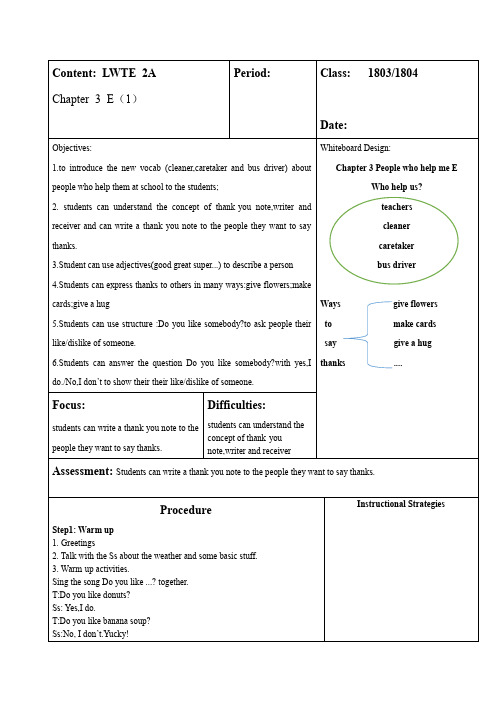
Explain the difference between note and letter
T:(ppt)Look, here are 2 thank-you notes.Who can read the notes for me?
Ss:Yes
T:Why?
Ss:...He is friendly and...
Step3 Practice
(ppt)T:Look at the pictures and make dialogues with your partner.
Happy face:like Sad face:dislike
2.students can understand the concept of thank-you note,writer and receiver and can write a thank you note to the people they want to say thanks.
3.Student can use adjectives(good great super...) to describe a person
Ss:...
T:Who do you think wrote the note? Ss: Charlie / Candy
T:Yes.He/She is the writer.
T:Who get the note?
Ss:Mr Ho/...
T:Yes.He/She is the receiver.
T:Does Charlie/Candy like...?
Content:LWTE 2A
香港朗文2A教案 chapter 6 E2

Period:
Class:
Date:
Objectives:
-Reviewvocabularyfrom Unit 6 part A.
playground, pond, snack bar, tennis court, swimming pool, toilets
Show a picture of the park from part E on the PPT. Ask students“What can you see?”to get their interest.
Ask“Where is the…..?”.
Then ask students,“What can we do in the swimming pool?”
1–wash our hands
2 - swim
3 - play tennis
4 - feed the ducks
5–pick flowers
6–eat snacks
7–play
Show dialogue from part E on PPT.
a) I want to swim.
b) Don’tswim here. You can go to the swimming pool.
Startto use part E sentence structure correctly.
Difficulties:
Vocabulary from part A is difficult for some students.
e.g between, in front of
Assessment:
Students will practice dialogue in pairs.
香港朗文2A教案 Chapter 4 People at work C2
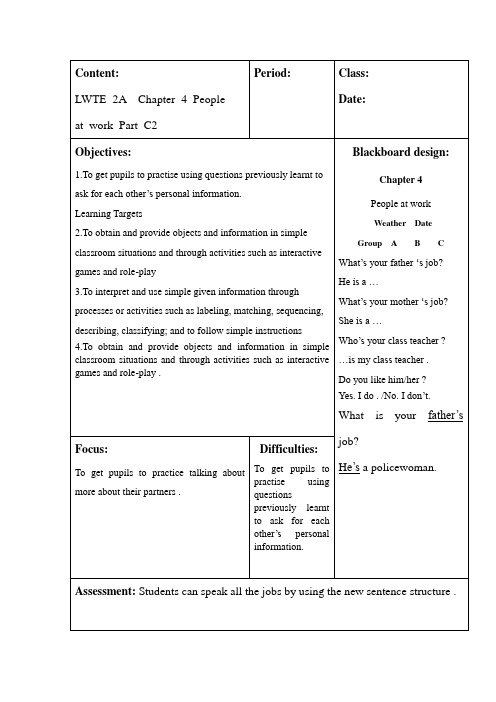
Yes. I do . /No. I don’t.
What is yourfather’sjob?
He’sa policewoman.
Focus:
To get pupils to practice talking about more about their partners .
3.To interpret and use simple given information through processes or activities such as labeling, matching, sequencing, describing, classifying; and to follow simple instructions
Procedure
Step 1:warm up
T:Good morning, class! Lets sing a song together. “ T: What day is it today?
S:It’s Tuesday.
T: How is the whether today?
Step2 :Presentation
Learning Targets
2.To obtain and provide objects and information in simple classroom situations and through activities such as interactive games and role-play
People at work
Weather Date Group A B C
What’s your father ‘s job?
香港朗文2A教案 第五单元signs we see第六课时
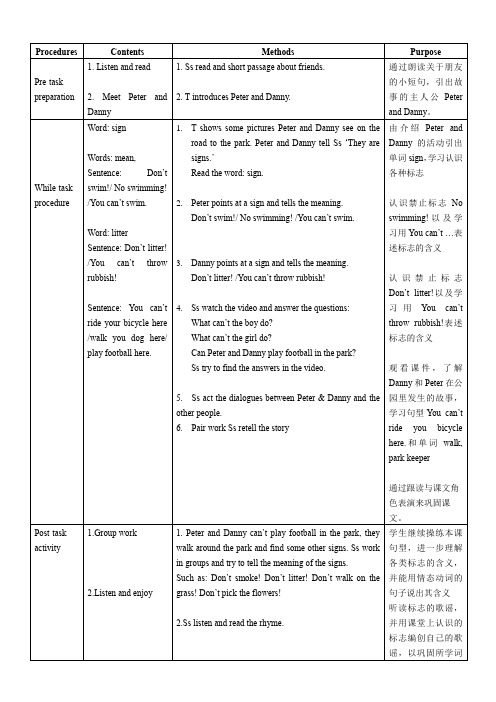
Post-task activity
1.Group work
2.Listen and enjoy
1. Peter and Danny can’t play football in the park, they walk around the park and find some other signs. Ss work in groups and try to tell the meaning ofthesigns.
Sentence: You can’t ride your bicycle here /walk you dog here/ play football here.
1.T shows some pictures Peter and Danny see on the road to the park. Peter and Danny tell Ss‘They are signs.’
You can’t play football here.It means‘No ball games.’/ Don’t play ball games (football) here.
教学反思
通过朗读关于朋友的小短句,引出故事的主人公Peter and Danny。
While-task procedure
Word: sign
Words:mean,
Sentence: Don’ swim!/ No swimming! /You can’t swim.
Word: litter
Sentence: Don’t litter! /You can’t throw rubbish!
You can’t ride your bicycle here.It means‘No bicycles’. /‘Don’t ride your bicycle here!’
香港朗文2A英语学期教学计划

2. 在教学过程中注重语境的创设和活动的增加,多给学生展示的机会,让他们在一年级的基础上更大胆地开口说英语,更自信;
3. 进一步规范学生书写,让学生写一手漂亮的英文字。
4.1A时学习了26个字母的发音,重读开音节,重读闭音节,本册除了掌握书上的语音知识以外,视情况加入字母组合发音的教学;
7. 练习形式多种多样,手,脑, 眼,肢体并运用,静态,动态结合,基本功操练与自由练习相结合,单项和综合练习结合。通过大量的实践,使学生具有良好的语音,语调,书写和拼读的基础。
8. 严格执行学校课程处规定,1-2 年级无书写作业,每周5次视频作业,科学、合理而有序地布置家庭作业,做到减压减负,快乐学习。
5. 设置多样化的英语活动,调动学生学习积极性,设置“口语小达人”、“书写小能手”、“阅读之星”“学术之星”等奖项,结合积分银行设置并给予一定精神奖励。
6. 多教授chant 和歌谣或小故事等促进多单词和句型的记忆。充分利用教科书中的课文创设富有生活气息的情景,并且进行一定的延伸加入自己的特色和元素;
9.根据“备、教、批、辅、考”的基本要求,每堂课结束后进行检测,注重所有学生的培辅并做好记载,努力提高班级学生的英语学习成绩,并逐步提升其实操应用技能。
本学期二年级学生的学习书目以香港朗文2A为主:
1、从话题内容上
话题上包括交通工具、个人信息、地点表述、人称、礼貌用语、职业、标识、公园地点、方位介词、动词短语等,以及从简单的自我陈述到运用简单疑问句和特殊疑问句进行提问和交流。
2、从语法内容上
(1)词性
- 代词:
人称代词(主格:I;you:he;she;it;they、所有格:my;our;your;his;her);物主代词(this;that;these;those);疑问代词(how,how many, who, when, where, why);不定代词(one)
二年级香港朗文2A英语教案

课题:剑桥英语1级U2 和课本U2课时:6课时教学重点:1句型:Where do you live? I live in ...2问名字并回答What’s your name? My name is ...3问年龄并回答How old are you? I’m...4问电话号码What’s your telephone number? It’s 232345465字母A-----F6 人称代词和物主代词的认识7 动物的词汇教学难点:特殊疑问词Where 的用法,用来问地点。
介词in 的运用。
数字0到10的英语说法及熟练运用。
教学目标:学生能在日常生活中熟练运用本课句型;能正确书写和认读字母A到F;认识并会运用人称代词和物主代词。
教学方法:情景教学,任务型教学1---3课时教学过程:Step1 复习上次课的内容1单词:写出相应的中文或英文bus ________________ 迷你巴士______________________地铁_______________ LRT___________________________电车_______________ train___________________________女孩__________________ 的士_______________________________ ferry__________________ pupil _______________________________2 情景对话How do you come to school?I come to school on.../by...注意:I come to school on foot.的同义句是:______________________________________.3连线题Ask your friends 然后组成小组Come on , Wendy 去问一下你的朋友们Then get into groups 来吧,WendyJoin a group 加入一个小组4认读单词Let’s group bike boat motorbike plane Helicopter lorry too also driveStep2 新授句型对话:1 Where do you live?I live in... (换不同的地点练习)2What’s your name?My name is Kitty.(互问)3复习0到10的数字的英语表达出示数字卡片,让学生说英语,或者老师说英语学生反应数字。
香港朗文2A教案 chapter2 about me C
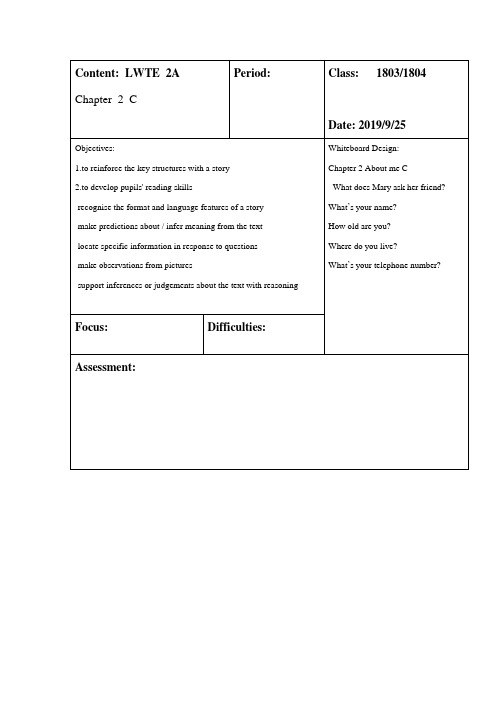
Step3 :Presentation
Pre-reading
T:Today we will read a new story about two girls , Mary and Kitty.
Click to show the name Mary .Draw pupils’attention to the dancing figures on the wall and the dancing shoes in Mary’s bag.
Click to show the name Kitty .
T:This is Mary's new friend , Kitty
Click to show the guiding question .
T:What does Mary ask her new friend ? Can you guess ? -
Content:LWTE 2A
Chapter 2 C
Period:
Class: 1803/1804
Date: 2019/9/25
Objectives:
1.to reinforce the key structures with a story
2.to develop pupils' reading skills
-make observations from pictures
-support inferences or judgements about the text with reasoning
Whiteboard Design:
Chapter 2 About me C
What does Mary ask her friend?
香港朗文2A教案 chapter 5 signs we see AB1
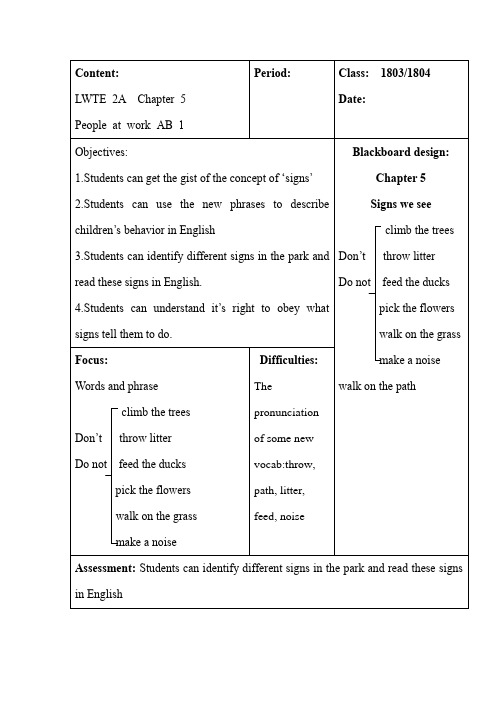
Explain don’t= do not
Show the signs on ppt and ask students to read the signs
Don’t climb the trees
Don’t walk on the grass
Don’t walk on the path
Content:
LWTE 2A Chapter 5
People at workA1804
Date:
Objectives:
1.Students can get the gist of the concept of ‘signs’
2.Students can use the new phrases to describe children’s behavior in English
3.Students can identify different signs in the park and read these signs in English.
4.Students can understand it’s right to obey what signs tell them to do.
Are those good behavior?
T:Who’s that ? S:park keeper
T:What does a park keeper do?
Where does a park keeper work?
What will the park keeper say to the children?
Don’t feed the ducks
Don’t pick the flowers
新版香港朗文英语二年级上册Chapter2Organisingideasusingnotes语法课件
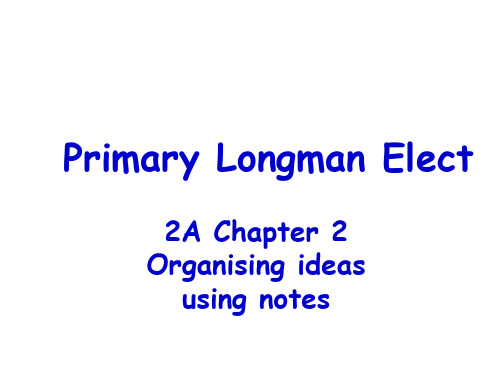
2A Chapter 2 Organising ideas
using notes
I want to make a poster of rules for the school library. Can you help me?
What rules can you think of?
eat
1. You must keep quiet.
2. You mustn’t litter.
3. You mustn’t drink.
4. You mustn’t eat.
Well done! Here’s our poster of rules for the school library!
eat
1. You must keep quiet.
2. You mustn’t litter.
3. You mustn’t drink.
= You mustn’t
In the library
You must keep quiet
YYoouu mmuussttnn’’tt litter drink
drink
eat
✓ = You must
In the library
You m✓ust keep quiet
litter drink eat
1. You must keep quiet.
Don’t forget the full stop.
= You mustn’t
In the library
What mustn’t () we do in the library?
In the library
✓
香港朗文2Bchapter2教案第二课时
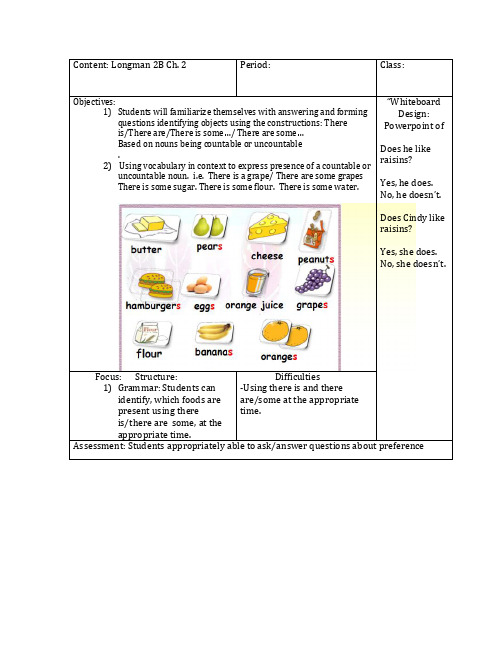
Content: Longman 2B Ch. 2 Period: Class:Objectives:1)Students will familiarize themselves with answering and formingquestions identifying objects using the constructions: Thereis/There are/There is some…/ There are some…Based on nouns being countable or uncountable.2) Using vocabulary in context to express presence of a countable oruncountable noun. i.e. There is a grape/ There are some grapesThere is some sugar. There is some flour. There is some water.“WhiteboardDesign: Powerpoint of Does he like raisins? Yes, he does. No, he doesn’t. Does Cindy like raisins? Yes, she does. No, she doesn’t.Focus: Structure:1)Grammar: Students canidentify, which foods arepresent using thereis/there are some, at theappropriate time. Difficulties-Using there is and there are/some at the appropriate time.Assessment: Students appropriately able to ask/answer questions about preferenceProcedure:I.Warm-up1)Greeting: Good morning boys and girls. Are youhot/cold?2)Warm-up song: “Do you like Spaghetti Yoghurt ?”3)Discuss the song with the studentsII.Revision: Have Student ReviewT: Do you like broccoli ice cream? (ask all the students)S: Yes, I do. Yummy!/ No, I don’t. Yucky!/Yes, we do!T: Do you like broccoli ice cream? (ask a girl)S: No, I don’t.T:Does she like broccoli ice cream?S:No, she doesn’t.T: Do you like broccoli ice cream? (ask a boy)S: Yes, I do.T:Instruct a student to ask the questionS: Does he like broccoli ice cream?S: Yes, he does. (Whole class)III.Presentation: Review of the question formation and answering1)Ask them to use the pattern There is/are2)Teach them to ask the questions3)Have them look in the fridge and answer questions?4)Have them ask questions?5)Show- the students sentences and have them rephrase them as Instructional Strategies。
香港朗文2A教案 chapter2 about me E
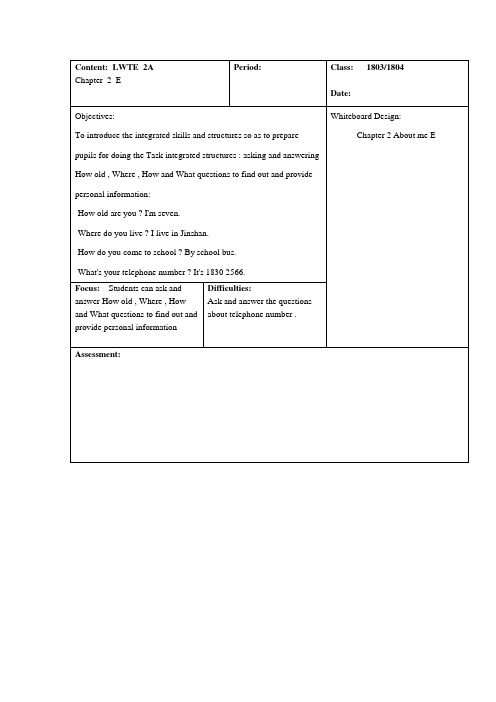
Video:Where do we live?
T:Where do we live? Ss: China/ Yichang/earth....
Quickly response
Ask some questions about personal information.
1.What’s your name?
1.Let Ss Fill in the blank based on the information they got from their friends just now.
2.Show time
Step 5: Summary
Review the knowledge by using the mindmap.
Whiteboard Design:
Chapter 2 About me E
Focus:Students can ask and answer How old , Where , How and What questions to find out and provide personal information
Ss: ...
Ask the new student to answer those questions and write down the information in the mindmap the blackboard.
T:This is a mindmap about personal information.
-How old are you ? I'm seven.
-Where do you live ? I live in Jinshan.
香港朗文2A教案 Chapter3 E2

Step3 Practice
Ask students to choose a person who help them and make a notes in table.
Who helps you?
What is his/her job?
Procedure
Step1: Warm up
1. Greetings
2.Talk with the Ss about the weather and some basic stuff.
3. Warm-up activities.
Sing the song Do you like ...? together.
Who help us?
teachers
cleaner
caretaker
bus driver
Ways give flowers
to make cards
say give a hug
thanks write a thank-you note
Focus:
students can write a thank you note to the people they want to say thanks.
Homework
Finish the thank-you note and sent it to the person you want to say thank you.
6.Students can answer the question Do you like somebody?with yes,I do./No,I don’t to show their their like/dislike of someone.
(完整版)朗文2A教学方法
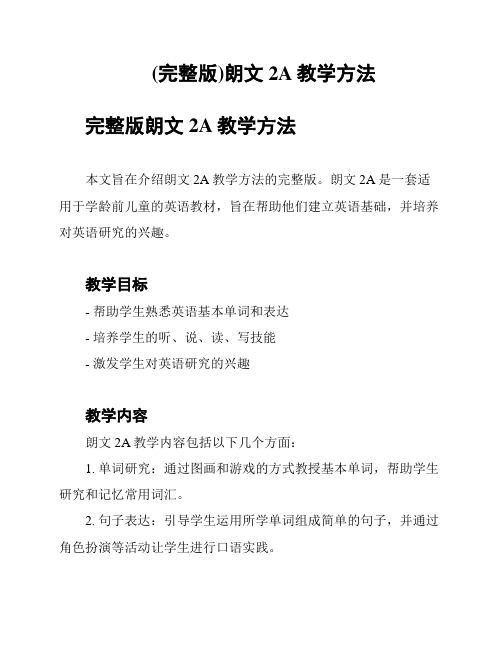
(完整版)朗文2A教学方法完整版朗文2A教学方法
本文旨在介绍朗文2A教学方法的完整版。
朗文2A是一套适用于学龄前儿童的英语教材,旨在帮助他们建立英语基础,并培养对英语研究的兴趣。
教学目标
- 帮助学生熟悉英语基本单词和表达
- 培养学生的听、说、读、写技能
- 激发学生对英语研究的兴趣
教学内容
朗文2A教学内容包括以下几个方面:
1. 单词研究:通过图画和游戏的方式教授基本单词,帮助学生研究和记忆常用词汇。
2. 句子表达:引导学生运用所学单词组成简单的句子,并通过角色扮演等活动让学生进行口语实践。
3. 阅读理解:通过阅读绘本和短文,培养学生的阅读理解能力,并提高他们的识字能力。
4. 写作训练:引导学生进行简单的写作活动,例如写下自己的
名字、简单句子等,培养他们的写作能力。
教学方法
为了提高教学效果,我们应该采用以下的教学方法:
1. 游戏化教学:通过游戏、歌曲和绘本等多样化的教学资源,
激发学生的研究兴趣,增强记忆力和认知能力。
2. 情景教学:将英语教学与日常生活场景结合起来,让学生在
实际情境中使用英语表达,增强他们的语言运用能力。
3. 合作研究:鼓励学生之间合作,进行小组活动和角色扮演,
让他们相互交流和互动,提高口语表达能力。
4. 多媒体辅助教学:使用多媒体教学工具如电子白板、录音机等,将英语教学变得更生动有趣,帮助学生更好地理解和研究。
以上就是朗文2A教学方法的完整版介绍。
通过采用这些教学
方法,我们相信学生将能够在轻松愉快的研究氛围中提高他们的英
语水平和研究能力。
参考文献:。
香港朗文2A教案 2A Chapter1 revision
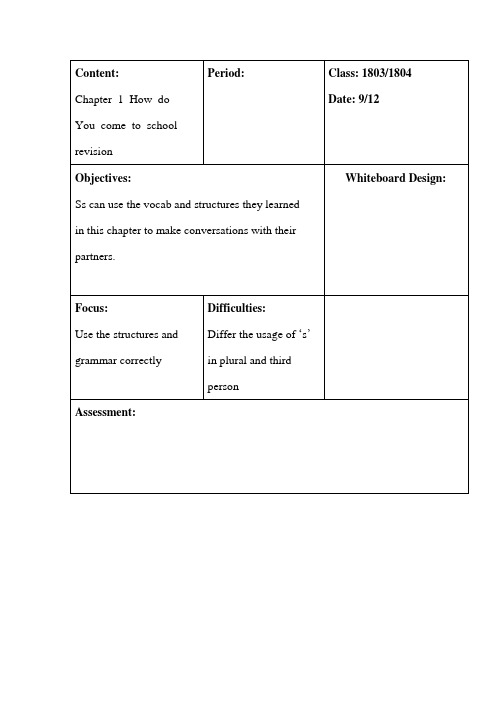
T: How many pupils come to school ...
Ss: ... pupil(s) come(s) to school ...
Hide some parts of the sentences which Ss are easy to make mistakes, and let Ss to fill in the blanks
Review the usage of‘s’in third person,then let the Ss to fill in the blanks.
Task 6 find the mistakes (grammar revision)
Let Ss to find the mistakes in sentences on ppt then recite them.
1.Greeting
2.Sing a song together : Part F How do you come to school?(task 1)
Purpose of design:
Step 2:review
Task 2 fast reaction(vocab revision)
Display different means of transportation one by one on ppt, let students to answer which transportation it is.
T: How does ... come to school?
Let Ss use target structure she/he/it/Ben comes to school by... to answer the questions.
香港朗文2A教案 2A Chapter1 F
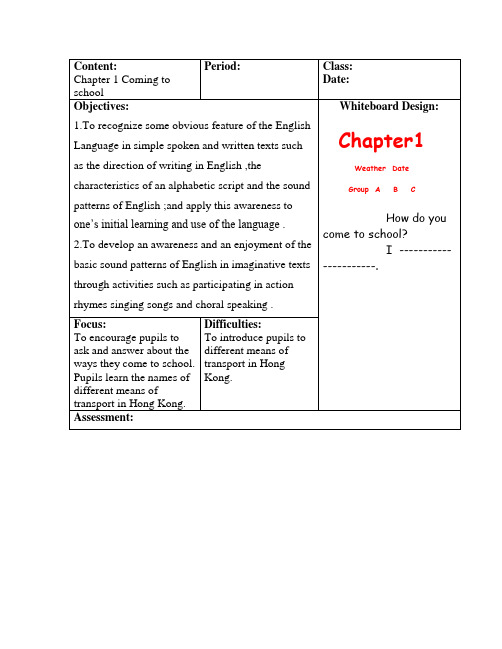
Chapter 1 Coming to school
Period:
Class:
Date:
Objectives:
1.To recognize some obvious feature of the English Language in simple spoken and written texts such as the direction of writing in English ,the characteristics of an alphabetic script and the sound patterns of English ;and apply this awareness to one’s initial learning and use of the language .
2. Play the song and tell pupils to follow the words with their fingers.
3. Play the song again and ask pupils to sing song along .
4. Tell pupils to fill in the blank individually to tell how they come to school .
Step3:Practice
1. Let the Ss talk with their partner how to sing the song .
2.Have a competition(let each of a group come to the board to have a competition ,who is better, I will give a star )
香港朗文2AChapter2教案
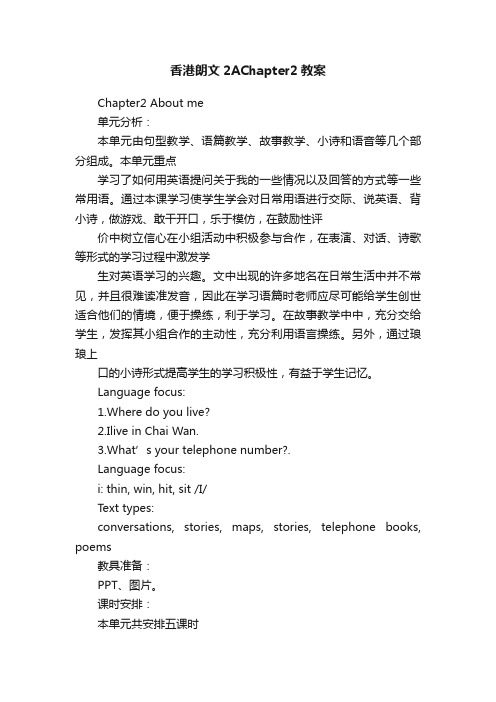
香港朗文2AChapter2教案Chapter2 About me单元分析:本单元由句型教学、语篇教学、故事教学、小诗和语音等几个部分组成。
本单元重点学习了如何用英语提问关于我的一些情况以及回答的方式等一些常用语。
通过本课学习使学生学会对日常用语进行交际、说英语、背小诗,做游戏、敢干开口,乐于模仿,在鼓励性评价中树立信心在小组活动中积极参与合作,在表演、对话、诗歌等形式的学习过程中激发学生对英语学习的兴趣。
文中出现的许多地名在日常生活中并不常见,并且很难读准发音,因此在学习语篇时老师应尽可能给学生创世适合他们的情境,便于操练,利于学习。
在故事教学中中,充分交给学生,发挥其小组合作的主动性,充分利用语言操练。
另外,通过琅琅上口的小诗形式提高学生的学习积极性,有益于学生记忆。
Language focus:1.Where do you live?2.Ilive in Chai Wan.3.What’s y our telephone number?.Language focus:i: thin, win, hit, sit /I/Text types:conversations, stories, maps, stories, telephone books, poems教具准备:PPT、图片。
课时安排:本单元共安排五课时Chapter2 About me (Period 1)一、Teaching contents:《International Edition Longman Welcome to English》Chapter2 About me Part A二、Teaching aims1. Aims of knowledgea. To introduce pupils to different means of places in Hong Kong.b. To encourage pupils to learn the names of some districts in Hong Kong.c. To encourage pupils to ask and answer about the ways they come to school.d. Ask and answer about the districts they live in .2. Aims of abilitiesa. Use simple sentences to communicate with others.b. Use interrogative pronouns to find out specific information about transport inHong Kong.c. To establish and maintain relationships and routines in carring out classroomof emotionDevelop participatory, cooperative, love and caring attitudes三、Difficult and key pointsKey points:encourage pupils to learn the names of some districts in Hong Kong.b. Pupils learn the names of different means of districts in Hong Kong.encourage pupils to ask and answer about the ways they come to school.Difficult points:To introduce pupils to know the pronunciations of districts in Hong Kong.四、Teaching aids1. flash cards2. PPT五、T eaching procedure:Step 1. Warm-up1. Greetings2. Warm-up activities.with the SsStep 2. Presentation1. Good morning class! Nice to meet you .What’s the weather like today ? What day is it today?2. What’s this ?It’s a map .Look . We can find some places from this map .Do you know where weShoware ? We are in Xi’an . Xi’an is a good place. Show the area of Xi’the question Where do you live ? Find a student to answer .Then teach the questionWhere do you live ? and the answer by using together ,group by group ,one byone .Then ,Go round the class asking pupils where they live .It doesn’t matter if they allanswer with the same district . The most important thing is that they understand theconcept.Now ,look ,this is the New Territories .This is Kowloon .This isHong KongIsland .Let’s learn it together .Teach different names of the New T erritories by using the flash cards.This is ….the question form. Then go round the class asking questions and elicitinganswers.Do you know here ?This is …,listen to the E –book and follow .teacherand girls read ,Step 3. Conclusionthe Ss talk with their partner by using the questions they have learned. the new words andhave a competition(let each of a group come to the board to have a competition ,who is quicker ,I will give a star )3. Ask who can read the names of places .六、Homework1.Copy the words 3 times and try to remember them.2.Follow the CD read part A七、 Blackboard writing八、Reflection after class:Chapter2 About me (Period 2)一、 Teaching contents :《International Edition Longman Welcome to English 》Chapter2 About me (Period2) Part A & PartB二、Teaching aims1. Aims of knowledgea. To interpret and use simple given information through processes or activities such as labeling, matching, sequencing, describing,classifying;and to followsimple instructionsb. To introduce pupils to different means of places in Hong Kong.c. To encourage pupils to learn the names of some districts in Hong Kong.d. To encourage pupils to ask and answer about the ways they come to school.e. Ask and answer about the districts they live in . 2. Aims of abilitiesa. Use simple sentences to communicate with others.b. Use interrogative pronouns to find out specific information about transport in Hong Kong.c. To establish and maintain relationships and routinesin carry out classroomactivities. 3. Aims of emotionDevelop participatory, cooperative, love and caring attitudes 三、Difficult and key points Key points:encourage pupils to learn the names of some districts in Hong Kong.Chapter2 About meWeather DateGroup A B C A: Where do you live?B: I live in … .Sha Tin Tuen Mun Tsuen Wan Kowloon Mong Kok Kwun TongChai WanWan Chailearn the names of different means of districts in Hong Kong.encourage pupils to ask and answer about the ways they come to school.Difficult points:a. To introduce pupils to know the pronunciations of districts in Hong Kong.四、Teaching aidscards五、Teaching procedure:Step1. Warm-up1. Greetings2. Warm-up activities.with the SsStep 2. Presentationthe weather like today ? What day is it morning class! Good morning. What’stoday?! You did a nice job ,who can answer my question ? Look at the screen .(PPT).Review the words they have learn. Using the flash cards, cover them and askpupils to spell them keep repeatingReview the sentence byer.Where do you live ? I live in … ask questions and let them answCorrect them when they were wrong.and let them listen to the sample3. Ask questions “Where d oes Sally live ?”conversations in part A .After listening the students should answer theteacher’s question.4. Follow the CD to read the part A together. T hen group by group. (Ok ,let’s havea competition ,who is better I will give a sticker)5. Listen to the E-book again ,point and say .6 .Boys and girls read ,teacher, let’s go ahead , who want to show us this conversation ,hands up .(choose two Ssto act the conversation)Stepthe Ss talk with their partner and do the Part B together.A: where do you live, xxx?B: I live in … .the answerconversationthe sentences they have learned instead of the text.六、 Homework1. Recite part A.the part A to your parents and answer part B in pairs. 七、Blackboard writing七、Reflection after class: Chapter2 About me( Period 3)一、T eaching Contents《朗文英语》2A Chapter 2第三课时 Part C&D二、 Teaching aims1. Aims of knowledge develop pupils’reading skills and stimulate their critical thinking ability. obtain and provide information in simple classroom situations and through activities such as interactive games and role-play.c. To provide or find out and present simple information on familiar topics. e. Use the simple present tense to express opinions. 2. Aims of abilitiesa. To provide or find out and present simple information on familiar topicsb. Use interrogative pronouns to find out specific information about some places in Hong Kong.simple sentences to communicate with others . 3.Aims of emotiona..Develop participatory, cooperative ,love and caring attitudesb. To develop pupils’reading skills and stimulate their critical thinking ability.三、Difficult and key pointslearn to ask and answer about the ways they come to school and other ’s telephonenumber. learn somepronunciation of new words .四、Teaching aidsFlash card , CD , super E-book五、Teaching procedure:1. Warm up 1) Greet to pupilsChapter2 About meA: Where do you live,xxx ? B: I live in… .Sha Tin Tuen Mun Tsuen Wan Kowloon Mong KokKwun TongChai WanWan Chai2). Warm-up activities.3).Talk with the Ss2. Presentation1). Good morning class! Good morning. How are you? What’s the weather like today?What day is it today?2). Ok ! You are great . who can answer my question ? look at the screen .(PPT). Whatdoes the teacher want to know? What do the pupils need to do ?(Arouse pupils’interest in reading by asking questions)3).Ask questions about the story .How many Girls are there in the story?Do they know each other?4). Introduce the topic of telephone you have a telephone at home?If you want to get in touch with your friends, you need to know their telephonenumbers.5).Teach the question what’s your telephone number? And the way to say telephonenumbers. Teach 0 as zero or oh. Teach double and triple for repeated numbers, three, 444=triple four. Practise with different numbers.W hat’s your telephone number, May?T; My telephone number is …Pl: It’s…T: Thank you. What about you, tony? What’s your telephone number?P2:It’s …T: Good. Thank you.6).Pre-teach any new words.7).Tell pupils to read the story once silently.8).Ask questions about the story.What’s the name of mary’s new friend?(kitty.)Where’s mary’s telephone number?(2333 4440.)Are the two girls neighbours?(yes.)9).Get pupils to act the story in groups. Ask one or two groups with lively intonationand reasonably accurate pronunciation to come to the front to perform.10). Check pupils’ answers to part D.11). Listen to the E-book again , point and say .12).Boys and girls read ,Little teacher3.Consolidation1).Read the text2).Let them practise some telephone number1). Read part C and try to recite it.2).Ask your friend’s telephone number六、. Blackboard writingChapter2About meHow do Mary and Kitty meet ?Where do they live ?七、Reflection after classChapter2 About me (Period 4)一、Teaching Contents《朗文英语》2A Chapter 2第四课时 Part E二、 Teaching aims1. Aims of knowledgeget pupils to practice using questions previously learnt to ask for personal information.obtain and provide information in simple classroom situations and through activitiessuch as interactive games and role-play.get pupils to practice talking about more about their friends .2.Aims of abilitiesestablish and maintain relationships and routines in carrying out classroom activities.interpret and use simple given information through processes or activities such aslabeling, matching, sequencing, describing, classifying; and to follow simple instructions.get pupils to practice talking with others.3.Aims of emotiona. Develop confidence in using English through performing tasks on their own or ingroups.participatory, cooperative, love and caring attitudes.三、Difficult and key pointsget pupils to practice talking about more about their friends .the beauty of the language through enjoying reading simple conversations.pupils of the difference between How are you ?and How old are you ?.provide or find out and present simple information on familiar topics.四、Teaching aidsFlash card , CD , super E-book五、Teaching procedure:1. Warm up1). Greet to pupils2). Warm-up activities.3).Talk with the Ss.2. Presentation1). Hello, class! Good morning. Nice to meet you What’s the weather like today? Whatday is it today?2).Talk with a studentHello,…How old are you ?Where do you live ?How do you come to school ?What is your telephone number ?Ok ! You are great. Ok ,you are so clever3).Now who can ask questions like me ?(Ask a pupil to come to the stage )4).Ok ,excellent .Now talk with your pairs ,pupils act T om and the teacher .They askand answer questions based on the information provided on the blackboard .Go roundthe class checking their understanding.6)Listen to the E-book7)point and say . Read the sample conversations in partE.8).Follow the CD to read part E together. Then group by group .(Ok ,let’s have a co mpetition ,who is better I will give a sticker) and girls read ,9).Little teacher10).Check pupils’answers to Part E.1). Let the Ss talk with their partner by using the basic questions.2)Tell Ss to find out more informations about their friends.1).Read part E and try to recite it .2).Act the part E to your parents六、. Blackboard writingChapter2 About meHow old …?----.Where …?I live in …七、Reflection after classChapter2 About me (Period 5)一、Teaching Contents《朗文英语》2A Chapter 2第五课时 PartF &Phonics二、 Teaching aims1. Aims of knowledgeenable to pupils to enjoy and appreciate the English Language through a poem.recognise some obvious features of the English language in simple spoken andwritten texts such as the direction of writing in English, the characteristics of analphabetic script and the sound patterns of English; and apply this awareness to one’sinitial learning and use of the language.develp an awareness and an enjoyment of the basic sound patterns of English in imaginative texts through activities such as participating in action rhymes, singingsongs and choral speakingpupils to look at the PPT while they pronounce the /i/.2.Aims of abilitiesrecognize some obvious feature of the English Language in simple spoken and writtentexts such as the direction of writing in English ,the characteristics of an alphabeticscript and the sound patterns of English ;and apply this awareness to one’s initiallearning and use of the language .develop an awareness and an enjoyment of the basic sound patterns of English inimaginative texts through activities such as participating in action rhymes singingsongs and choral speaking .3. Aims of emotionAppreciate the beauty of the language through enjoying reading simple conversations.三、Difficult and key points1. Get pupils to look at the PPT while they pronounce the /i/.2. To enable to pupils to enjoy and appreciate the English Language through a poem.pupils to pronounce the /i/ in different words.四、Teaching aidsFlash card , CD , super E-book五、Teaching procedure:1. Warm up1). Greet to pupils2). Warm-up activities.3).Talk with the Ss2.PresentationWhat day1). Hi, class! Good morning. Nice to see you What’s the weather like today? is it today?2). Play the poem and tell pupils to follow.3). Read out the poem and tell pupils to listen carefully.4).Explain any words or expressions which pupils may find difficult to understand.5).Pupils read the lines of the poem after you. Try to ensure the chanting does notbecome too slow or expressionless.6).Invite pupils to read out the poem in groups or individually for the whole class. Give encouragement and recognition for their performance.Play the poem again and ask pupils to read poem along .7).Listen to the E-book point and say .8).Boys and girls read ,9).Little teacher10). Follow CD play the phonics game in the super E-Book .11).Get pupils to look at your mouth while you pronounce the/I/sound or play the video in the Super E-Book. Look at my mouth and read after me.12)Play the phonics game in the super E-book.Ask pupils if they know the similarity between the words thin and win. Tell them that the words have the same middle sound. Do the same with the other two words (hit and sit).Check pupils’ pronunciation of the/I/sounds by asking them to say the words tin and fit.(the/t/and/f/ sounds are taught in p1.)Make sure they use the short vowel/I/, not the long/i:/.Ask pupils to say other known words with the same sound.1) . Let the Ss talk with their partner how to read the poem. Let each of a group come to the board to have a competition ,who is better, I will give a star。
- 1、下载文档前请自行甄别文档内容的完整性,平台不提供额外的编辑、内容补充、找答案等附加服务。
- 2、"仅部分预览"的文档,不可在线预览部分如存在完整性等问题,可反馈申请退款(可完整预览的文档不适用该条件!)。
- 3、如文档侵犯您的权益,请联系客服反馈,我们会尽快为您处理(人工客服工作时间:9:00-18:30)。
课题:剑桥英语 1 级 U2 和课本 U2 课时: 6 课时 教学重点: 1 句型: Where do you live? I live in ...
2
3 4 5 6 7 教学
难点: 问名字并回答 What 's your name? My name is ... 问年龄并回答 How old are you? I 'm... 问电话号码 What 's your telephone number? It 's 23234546 字母 A ---- F 人称代词和物主代词的认识
动物的词汇 特殊疑问词 Where 的用法,用来问地点。
介词 in 的运用。
数字 0 到 10 的英语说法及熟练运用。
教学目
标: 学生能在日常生活中熟练运用本课句型; 能正确书写和认读字母A 到F ;
认识并会运用人称代词和物主代词。
教学方法:情景教学,任务型教学
1---3 课时
教学过程:
Step1 复习上次课的内容
1 单词:写出相应的中文或英文
bus _______________ 迷你巴士 __________________________________
地铁 ________________ LRT _____________________________
电车 ________________ train _____________________________
女孩 ____________________ 的士 ____________________________________________ ferry _________________ pupil __________________________________
2 情景对话
How do you come to school?
I come to school on.../by...
注 意 : I come to Step2 新授句型 对话: 1 Where do you live?
school on foot. 的 同 义 句 是
3 连线题 Ask your
friends Come on , Wendy
Then get into groups Join
a group
4 认读单词 Let 's
group
plane
Helicopter lorry too
然后组成小组 去问一下你的朋友们 来吧, Wendy 加入一个小组 bike boat also drive
motorbike
I live in... (换不同的地点练习) 2What 's your name?
My name is Kitty.(互问)
3 复习0 到10 的数字的英语表达出示数字
卡片,让学生说英语,或者老师说英语学生
反应数字。
4what 's=what is I 'm=I am
5 练习,填空_ your n am'es Kitty. do you live? ___ I live Wan Chai
写同义句
What's your name? I 'm Kitty.
My ruler/... your... her... his... Step4 总结,补充。
单词:文具,交通工具语法点:人称代词和物
主代词
2 补充:口语早上好及回答见到你很高兴及回答name?
Step3 记剑桥英语的单词和句型。
1 认读单词:a pen a pencil a pencil-case a
book a bag an eraser
2 把单词放进句型里记忆。
What 's this?
ruler
1 回忆本次课的知识点:句型:
What
What Where do you live? I live in...
's your name ? My name is ...
's this? It 's a...
It 's a ...
3 把单词连着物主代词记。
